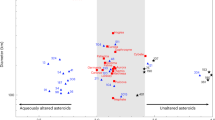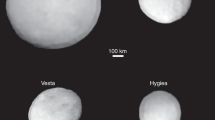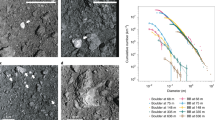Abstract
Asteroid (2) Pallas is the largest main-belt object not yet visited by a spacecraft, making its surface geology largely unknown and limiting our understanding of its origin and collisional evolution. Previous ground-based observational campaigns returned different estimates of its bulk density that are inconsistent with one another, one measurement1 being compatible within error bars with the icy Ceres (2.16 ± 0.01 g cm−3)2 and the other3 compatible within error bars with the rocky Vesta (3.46 ± 0.03 g cm−3)4. Here we report high-angular-resolution observations of Pallas performed with the extreme adaptive optics-fed SPHERE imager5 on the Very Large Telescope. Pallas records a violent collisional history, with numerous craters larger than 30 km in diameter populating its surface and two large impact basins that could be related to a family-forming impact. Monte Carlo simulations of the collisional evolution of the main belt correlate this cratering record to the high average impact velocity of ~11.5 km s−1 on Pallas—compared with an average of ~5.8 km s−1 for the asteroid belt—induced by Pallas’s high orbital inclination (i = 34.8°) and orbital eccentricity (e = 0.23). Compositionally, Pallas’s derived bulk density of 2.89 ± 0.08 g cm−3 (1σ uncertainty) is fully compatible with a CM chondrite-like body, as suggested by its spectral reflectance in the 3 μm wavelength region6. A bright spot observed on its surface may indicate an enrichment in salts during an early phase of aqueous alteration, compatible with Pallas’s relatively high albedo of 12–17% (refs. 7,8), although alternative origins are conceivable.
This is a preview of subscription content, access via your institution
Access options
Access Nature and 54 other Nature Portfolio journals
Get Nature+, our best-value online-access subscription
$29.99 / 30 days
cancel any time
Subscribe to this journal
Receive 12 digital issues and online access to articles
$119.00 per year
only $9.92 per issue
Buy this article
- Purchase on Springer Link
- Instant access to full article PDF
Prices may be subject to local taxes which are calculated during checkout




Similar content being viewed by others
Data availability
As soon as papers for our large programme are accepted for publication, we will make the corresponding reduced and deconvolved adaptive optics images and three-dimensional shape models publicly available at http://observations.lam.fr/astero/.
Code availability
The code used to generate the three-dimensional shape is available at https://github.com/matvii/ADAM. The modified SWIFT integrator used to model the orbital evolution of the Pallas family is available at http://sirrah.troja.mff.cuni.cz/mira/mp/.
References
Schmidt, B. E. et al. The shape and surface variation of 2 Pallas from the Hubble Space Telescope. Science 326, 275–278 (2009).
Park, R. S. et al. A partially differentiated interior for (1) Ceres deduced from its gravity field and shape. Nature 537, 515–517 (2016).
Carry, B. et al. Physical properties of (2) Pallas. Icarus 205, 460–472 (2010).
Russell, C. T. et al. Dawn at Vesta: testing the protoplanetary paradigm. Science 336, 684–686 (2012).
Beuzit, J. L. et al. SPHERE: the exoplanet imager for the Very Large Telescope. Astron. Astrophys. 631, A155 (2019).
Larson, H. P., Feierberg, M. A. & Lebofsky, L. A. The composition of asteroid 2 Pallas and its relation to primitive meteorites. Icarus 56, 398–408 (1983).
Tedesco, E. F., Noah, P. V., Noah, M. & Price, S. D. The supplemental IRAS minor planet survey. Astron. J. 123, 1056–1085 (2002).
Alí-Lagoa, V., Müller, T. G., Usui, F. & Hasegawa, S. The AKARI IRC asteroid flux catalogue: updated diameters and albedos. Astron. Astrophys. 612, A85 (2018).
Thalmann, C. et al. SPHERE ZIMPOL: overview and performance simulation. Proc. SPIE 7014, 70143F (2008).
Vernazza, P. et al. The impact crater at the origin of the Julia family detected with VLT/SPHERE? Astron. Astrophys. 618, A154 (2018).
Fusco, T. et al. Deconvolution of astronomical images obtained from ground-based telescopes with adaptive optics. Proc. SPIE 4839, 1065–1075 (2003).
Mugnier, L. M., Fusco, T. & Conan, J.-M. MISTRAL: a myopic edge-preserving image restoration method, with application to astronomical adaptive-optics-corrected long-exposure images. J. Opt. Soc. Am. A 21, 1841–1854 (2004).
Fétick, R. J. et al. Closing the gap between Earth-based and interplanet. mission observations: Vesta seen by VLT/SPHERE. Astron. Astrophys. 623, A6 (2019).
Scully, J. E. C. et al. Ceres’ Ezinu quadrangle: a heavily cratered region with evidence for localized subsurface water ice and the context of Occator crater. Icarus 316, 46–62 (2018).
Schmedemann, N. et al. The cratering record, chronology and surface ages of (4) Vesta in comparison to smaller asteroids and the ages of HED meteorites. Planet. Space Sci. 103, 104–130 (2014).
Hiesinger, H. et al. Cratering on Ceres: implications for its crust and evolution. Science 353, aaf4759 (2016).
Melosh, H. J. Impact Cratering: A Geologic Process (Oxford Univ. Press,1989).
Gladman, B. J. et al. On the asteroid belt’s orbital and size distribution. Icarus 202, 104–118 (2009).
Viikinkoski, M., Kaasalainen, M. & Durech, J. ADAM: a general method for using various data types in asteroid reconstruction. Astron. Astrophys. 576, A8 (2015).
Schenk, P. et al. The geologically recent giant impact basins at Vesta’s south pole. Science 336, 694–697 (2012).
Consolmagno, G., Britt, D. & Macke, R. The significance of meteorite density and porosity. Chem. Erde Geochem. 68, 1–29 (2008).
Vernazza, P. et al. Compositional homogeneity of CM parent bodies. Astron. J. 152, 54 (2016).
Doyle, P. M. et al. Early aqueous activity on the ordinary and carbonaceous chondrite parent bodies recorded by fayalite. Nat. Commun. 6, 7444 (2015).
Masiero, J. R. et al. Preliminary analysis of WISE/NEOWISE 3-band cryogenic and post-cryogenic observations of main belt asteroids. Astrophys. J. 759, L8 (2012).
Nathues, A. et al. Sublimation in bright spots on (1) Ceres. Nature 528, 237–240 (2015).
de León, J., Campins, H., Tsiganis, K., Morbidelli, A. & Licandro, J. Origin of the near-earth asteroid Phaethon and the Geminids meteor shower. Astron. Astrophys. 513, A26 (2010).
Todorović, N. The dynamical connection between Phaethon and Pallas. Mon. Not. R. Astron. Soc. 475, 601–604 (2018).
Trigo-Rodríguez, J. M., Llorca, J., Borovička, J. & Fabregat, J. Spectroscopy of a Geminid fireball: its similarity to cometary meteoroids and the nature of its parent body. Earth Moon Planets 95, 375–387 (2004).
Borovička, J., Koten, P., Spurný, P., Boček, J. & Štork, R. A survey of meteor spectra and orbits: evidence for three populations of Na-free meteoroids. Icarus 174, 15–30 (2005).
Borovička, J. Spectroscopic analysis of Geminid meteors. In Proc. 26th International Meteor Conference Bareges, France, 2007 (eds Rendtel, J. & Vaubaillon, J.) 42–51 (International Meteor Organization, 2010).
Kasuga, T., Watanabe, J. & Ebizuka, N. A 2004 Geminid meteor spectrum in the visible-ultraviolet region. Extreme Na depletion? Astron. Astrophys. 438, L17–L20 (2005).
Kasuga, T. Thermal evolution of the Phaethon-Geminid stream complex. Earth Moon Planets 105, 321–326 (2009).
Whipple, F. L. 1983 TB and the Geminid meteors. IAU Circular 3881 (1983).
Liu, Z. et al. A global database and statistical analyses of (4) Vesta craters. Icarus 311, 242–257 (2018).
Marchi, S. et al. The violent collisional history of asteroid 4 Vesta. Science 336, 690–694 (2012).
Marchi, S. et al. The missing large impact craters on Ceres. Nat. Commun. 7, 12257 (2016).
Pasckert, J. H. et al. Geologic mapping of the Ac-2 Coniraya quadrangle of Ceres from NASA’s Dawn mission: implications for a heterogeneously composed crust. Icarus 316, 28–45 (2018).
Morbidelli, A., Bottke, W. F., Nesvorný, D. & Levison, H. F. Asteroids were born big. Icarus 204, 558–573 (2009).
Cibulková, H., Brož, M. & Benavidez, P. G. A six-part collisional model of the main asteroid belt. Icarus 241, 358–372 (2014).
Werner, S. C. & Ivanov, B. A. in Treatise on Geophysics (ed. Schubert, G.) 2nd edn 327–365 (Elsevier, 2015).
Viikinkoski, M. et al. VLT/SPHERE- and ALMA-based shape reconstruction of asteroid (3) Juno. Astron. Astrophys. 581, L3 (2015).
Viikinkoski, M. Shape Reconstruction from Generalized Projections. PhD thesis, Tampere Univ. Technology (2016).
Marsset, M. et al. 3D shape of asteroid (6) Hebe from VLT/SPHERE imaging: implications for the origin of ordinary H chondrites. Astron. Astrophys. 604, A64 (2017).
Hanuš, J., Marchis, F., Viikinkoski, M., Yang, B. & Kaasalainen, M. Shape model of asteroid (130) Elektra from optical photometry and disk-resolved images from VLT/SPHERE and Nirc2/Keck. Astron. Astrophys. 599, A36 (2017).
McLean, I. S. & Chaffee, F. H. Instrumentation for the Keck Observatory. Proc. SPIE 4008, 2–7 (2000).
Burns, J. A. & Safronov, V. S. Asteroid nutation angles. Mon. Not. R. Astron. Soc. 165, 403–411 (1973).
Chambat, F., Ricard, Y. & Valette, B. Flattening of the Earth: further from hydrostaticity than previously estimated. Geophys. J. Int. 183, 727–732 (2010).
Rambaux, N., Chambat, F. & Castillo-Rogez, J. C. Third-order development of shape, gravity, and moment of inertia for highly flattened celestial bodies. Application to Ceres. Astron. Astrophys. 584, A127 (2015).
Lanzano, P. The equilibrium of a rotating body of arbitrary density. Astrophys. Space Sci. 29, 161–178 (1974).
Nesvorný, D., Brož, M. & Carruba, V. in Asteroids IV (eds Michel, P. et al.) 297–321 (Univ. Arizona Press, 2015).
Mainzer, A. et al. NEOWISE Diameters and Albedos V2.0 (NASA Planetary Data System, 2019); https://sbn.psi.edu/pds/resource/neowisediam.html
Ivezić, Ž. et al. Color confirmation of asteroid families. Astron. J. 124, 2943–2948 (2002).
Quinn, T. R., Tremaine, S. & Duncan, M. A three million year integration of the Earth’s orbit. Astron. J. 101, 2287–2305 (1991).
Levison, H. F. & Duncan, M. J. The long-term dynamical behavior of short-period comets. Icarus 108, 18–36 (1994).
Brož, M., Vokrouhlický, D., Morbidelli, A., Nesvorný, D. & Bottke, W. F. Did the Hilda collisional family form during the late heavy bombardment? Mon. Not. R. Astron. Soc. 414, 2716–2727 (2011).
Vokrouhlický, D. Diurnal Yarkovsky effect as a source of mobility of meter-sized asteroidal fragments. I. Linear theory. Astron. Astrophys. 335, 1093–1100 (1998).
Vokrouhlický, D. & Farinella, P. The Yarkovsky seasonal effect on asteroidal fragments: a nonlinearized theory for spherical bodies. Astron. J. 118, 3049–3060 (1999).
Čapek, D. & Vokrouhlický, D. The YORP effect with finite thermal conductivity. Icarus 172, 526–536 (2004).
Farinella, P., Froeschlé, C. & Gonczi, R. Meteorite delivery and transport. IAU Symp. 160, 205–222 (1994).
Alí-Lagoa, V. et al. Differences between the Pallas collisional family and similarly sized B-type asteroids. Astron. Astrophys. 591, A14 (2016).
Brož, M. & Morbidelli, A. A study of 3-dimensional shapes of asteroid families with an application to Eos. Icarus 317, 434–441 (2019).
Benz, W. & Asphaug, E. Impact simulations with fracture I—Method and tests. Icarus 107, 98–116 (1994).
Jutzi, M., Holsapple, K., Wünneman, K. & Michel, P. in Asteroids IV (eds Michel, P. et al.) 679–699 (Univ. Arizona Press, 2015).
Ševeček, P. et al. SPH/N-body simulations of small (D = 10 km) asteroidal breakups and improved parametric relations for Monte-Carlo collisional models. Icarus 296, 239–256 (2017).
Richardson, D. C., Quinn, T., Stadel, J. & Lake, G. Direct large-scale N-body simulations of planetesimal dynamics. Icarus 143, 45–59 (2000).
Tillotson, J. H. Metallic Equations of State for Hypervelocity Impact GA–3216 (General Dynamics, 1962).
von Mises, R. Mechanik der festen krper im plastisch- deformablen zustand. Nachr. Ges. Wiss. Gott. Math. Phys. Klasse 4, 582–592 (1913).
Grady, D. & Kipp, M. Continuum modelling of explosive fracture in oil shale. Int. J. Rock. Mech. Min. Sci. 17, 147–157 (1980).
Benz, W. & Asphaug, E. Simulations of brittle solids using smooth particle hydrodynamics. Comput. Phys. Commun. 87, 253–265 (1995).
Bottke, W. F. & Greenberg, R. Asteroidal collision probabilities. Geophys. Res. Lett. 20, 879–881 (1993).
Bottke, W. F. et al. Linking the collisional history of the main asteroid belt to its dynamical excitation and depletion. Icarus 179, 63–94 (2005).
Benz, W. & Asphaug, E. Catastrophic disruptions revisited. Icarus 142, 5–20 (1999).
Vilas, F. & Gaffey, M. J. Phyllosilicate absorption features in main-belt and outer-belt asteroid reflectance spectra. Science 246, 790–792 (1989).
Fornasier, S., Lantz, C., Barucci, M. A. & Lazzarin, M. Aqueous alteration on main belt primitive asteroids: results from visible spectroscopy. Icarus 233, 163–178 (2014).
Cloutis, E. A. et al. Spectral reflectance properties of carbonaceous chondrites 4: aqueously altered and thermally metamorphosed meteorites. Icarus 220, 586–617 (2012).
Lantz, C. et al. Ion irradiation of carbonaceous chondrites: a new view of space weathering on primitive asteroids. Icarus 285, 43–57 (2017).
Rivkin, A. S., Asphaug, E. & Bottke, W. F. The case of the missing Ceres family. Icarus 243, 429–439 (2014).
Castillo-Rogez, J. et al. Insights into Ceres’s evolution from surface composition. Meteorit. Planet. Sci 53, 1820–1843 (2018).
Howard, K. T., Benedix, G. K., Bland, P. A. & Cressey, G. Modal mineralogy of CM chondrites by X-ray diffraction (PSD-XRD): Part 2. degree, nature and settings of aqueous alteration. Geochim. Cosmochim. A 75, 2735–2751 (2011).
Alí-Lagoa, V. et al. Physical properties of B-type asteroids from WISE data. Astron. Astrophys. 554, A71 (2013).
Castillo-Rogez, J. C. et al. Iapetus’ geophysics: rotation rate, shape, and equatorial ridge. Icarus 190, 179–202 (2007).
Schmidt, B. E. & Castillo-Rogez, J. C. Water, heat, bombardment: the evolution and current state of (2) Pallas. Icarus 218, 478–488 (2012).
Opeil, C. P., Consolmagno, G. J. & Britt, D. T. The thermal conductivity of meteorites: new measurements and analysis. Icarus 208, 449–454 (2010).
Dufresne, E. R. & Anders, E. On the chemical evolution of the carbonaceous chondrites. Geochim. Cosmochim. A 26, 1085–1114 (1962).
Bland, P. A. & Travis, B. J. Giant convecting mud balls of the early Solar System. Sci. Adv. 3, e1602514 (2017).
Carry, B. et al. Homogeneous internal structure of CM-like asteroid (41) Daphne. Astron. Astrophys. 623, A132 (2019).
Alí-Lagoa, V. et al. Differences between the Pallas collisional family and similarly sized B-type asteroids. Astron. Astrophys. 591, A14 (2016).
Hanuš, J. et al. Shape, size, physical properties and nature of low-perihelion near-Earth asteroid (3200) Phaethon. In Proc. 48th AAS Division for Planetary Sciences Meeting 516.08 (American Astronomical Society, 2016).
Masiero, J. R., Wright, E. L. & Mainzer, A. K. Thermophysical modeling of NEOWISE observations of DESTINY+ targets phaethon and 2005 UD. Astron. J. 158, 97 (2019).
Kareta, T. et al. Rotationally resolved spectroscopic characterization of near-Earth object (3200) Phaethon. Astron. J. 156, 287 (2018).
Ito, T. et al. Extremely strong polarization of an active asteroid (3200) Phaethon. Nat. Commun. 9, 2486 (2018).
Cellino, A. et al. On the calibration of the relation between geometric albedo and polarimetric properties for the asteroids. Mon. Not. R. Astron. Soc. 451, 3473–3488 (2015).
Lupishko, D. F. Generalized calibration of the polarimetric albedo scale of asteroids. Solar Syst. Res. 52, 98–114 (2018).
Devogèle, M. et al. The phase-polarization curve of asteroid (3200) Phaethon. Mon. Not. R. Astron. Soc. 479, 3498–3508 (2018).
Shinnaka, Y. et al. Inversion angle of phase-polarization curve of near-Earth asteroid (3200) Phaethon. Astrophys. J. Lett. 864, L33 (2018).
Takir, D. et al. 3-μm spectroscopy of asteroid (3200) Phaethon: implications for B-asteroids. In Proc. 49th Lunar and Planetary Science Conference 2624 (LPI, 2018).
Arai, T. et al. DESTINY+ mission: flyby of Geminids parent asteroid (3200) Phaethon and in-situ analyses of dust accreting on the Earth. In Proc. 49th Lunar and Planetary Science Conference 2570 (LPI, 2018).
Gardner, J. P. et al. The James Webb Space Telescope. Space Sci. Rev. 123, 485–606 (2006).
Acknowledgements
Based on observations collected at the European Organisation for Astronomical Research in the Southern Hemisphere under ESO programme 199.C-0074 (principal investigator: P.V.). This research has made use of the Keck Observatory Archive (KOA), which is operated by the W. M. Keck Observatory and the NASA Exoplanet Science Institute (NExScI), under contract with NASA. M.M. was supported by the National Aeronautics and Space Administration under grant number 80NSSC18K0849 issued through the Planetary Astronomy Program. This work was supported by the French Direction Générale de l’Armement (DGA) and Aix-Marseille Université (AMU). P.V., A.D. and B.C. were supported by CNRS/INSU/PNP. J.H., J.D. and P.S. were supported by the grant 18-09470S of the Czech Science Foundation and by the Charles University Research Programme number UNCE/SCI/023. M.Brož was supported by the grant 18-04514J of the Czech Science Foundation. E.J. is a F.R.S.-FNRS Senior Research Associate. The work of T.S.-R. was carried out through grant APOSTD/2019/046 by Generalitat Valenciana (Spain). This project has received funding from the European Union’s Horizon 2020 research and innovation programme under grant agreement number 730890. This material reflects only the authors’ views and the commission is not liable for any use that may be made of the information contained herein.
Author information
Authors and Affiliations
Contributions
P.V. is the principal investigator of the ESO large survey that acquired the images of Pallas. M.M. and P.V. designed and operated the survey in service mode. M.M. led the research on Pallas. M.M., P.V., R.F. and T.F. reduced and deconvolved the SPHERE images. A.D. performed the crater analysis. M.Brož analysed the Pallas family and ran the N-body and SPH simulations. D.C.R and E.A. provided some of the numerical codes used for the simulations. B.C. and J.H. retrieved earlier disk-resolved and disk-integrated data for Pallas from the literature. M.V. and J.H. reconstructed the three-dimensional shape of Pallas. N.R. and L.J. analysed the shape. B.C. provided the mass estimate. J.C.-R. performed the compositional analysis and thermophysical modelling of Pallas. M.M., M.Brož, P.V. and J.C.-R. worked jointly to write the manuscript. All authors discussed the results and commented on the manuscript.
Corresponding author
Ethics declarations
Competing interests
The authors declare no competing interests.
Additional information
Peer review information Nature Astronomy thanks Julia de Leon and the other, anonymous, reviewer(s) for their contribution to the peer review of this work.
Publisher’s note Springer Nature remains neutral with regard to jurisdictional claims in published maps and institutional affiliations.
Supplementary information
Supplementary Information
Supplementary Figs. 1–11, Supplementary Tables 1–8 and corresponding references.
Rights and permissions
About this article
Cite this article
Marsset, M., Brož, M., Vernazza, P. et al. The violent collisional history of aqueously evolved (2) Pallas. Nat Astron 4, 569–576 (2020). https://doi.org/10.1038/s41550-019-1007-5
Received:
Accepted:
Published:
Issue Date:
DOI: https://doi.org/10.1038/s41550-019-1007-5
This article is cited by
-
Acquisition and Preservation of Remanent Magnetization in Carbonaceous Asteroids
Nature Astronomy (2022)
-
Determining the Relative Cratering Ages of Regions of Psyche’s Surface
Space Science Reviews (2022)
-
The Psyche Topography and Geomorphology Investigation
Space Science Reviews (2022)



